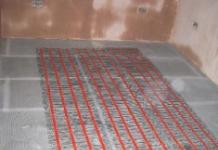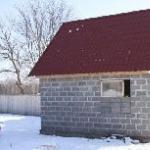Limestone is a sedimentary rock of organic origin. There is also a chemogenic origin of limestone, when the rock is formed as a result of chemical precipitation during the evaporation of water or from aqueous solutions. The basis of the rock is mainly calcium carbonate, presented in the form of calcite crystals of various sizes. The extraction of limestone is in demand, since a person uses this rock in many areas.
Description
The basis of limestone is calcium carbonate - a substance that can dissolve in water. As a result, karst is formed. It can decompose into bases and carbon dioxide. This is carried out at great depths, because due to the influence of the heat of the Earth, limestone forms a gas for mineral waters.
Limestone may include impurities of clay minerals, dolomite, quartz, gypsum, pyrite. Natural limestone has a light gray color, although it can be black and white. Impurities give a blue, pink, yellow tint. Limestone mining is in demand because of its wide application. The breed is durable, known for its unique characteristics that make it unlike other materials.
Classification
A common type of rock is the shell rock, which consists of the shells of marine animals and their fragments. There are other types of limestone:
- Bryozoan, which includes the remains of bryozoans - small invertebrates living in colonies in the seas.
- Nummulitic, consisting of extinct unicellular organisms nummulites.
- Marble. It happens thinly layered and massively layered.
During metamorphism, limestone undergoes a process of recrystallization, due to which this rock forms marble. 
Monomineral rock is considered to be limestone, the method of extraction of which may differ, depending on the type of impurities, structure, geological age. There are organizations that mine limestone. Places and methods of extraction are determined by the terrain, types of rocks and other characteristics.
Place of Birth
As can be seen from the above, limestone is considered to be a sedimentary rock that appeared with the participation of living organisms living in sea basins. The breed is mined in many regions of our country and other states. Russia is considered one of the leaders in terms of its presence.
Limestone is considered the "building material" for mountain ranges. An example is the Alps, although it can occur in other mountainous areas. Limestone mining takes place all over the world. There are many reserves in our country. Moreover, all limestone mining sites make it possible to obtain different types of natural material: dense, white, flux, shell-oolitic.
Limestone mining is known in Russia. Deposits are popular in the western part of the country. Developments are carried out from the Belgorod and Tula regions to Moscow, the Vologda, Voronezh regions. Mining is carried out near St. Petersburg, in the Krasnodar Territory, Arkhangelsk, in the Urals, in Siberia. Of the neighboring countries, there are deposits in the Donetsk region of Ukraine.
Mining methods
Mining is carried out by an open pit method. The top layer of soil and clay is removed. This is how a quarry is formed. Limestone mining involves pyrotechnical work to crush and detach portions of rock. Then it is taken out by cars for processing. 
The breaking method is considered the world's first mining method. This name was obtained due to the fact that the rock was removed with crowbars, and then stones were knocked out of the formation with hammers. An alternative to this method is now being used. Explosive method is used. A small crumb is obtained from the breed. The excavator collects it, loads it onto dump trucks, and then everything is transported to the plant, where it is processed and cleaned.
There is a special device for the excavator, with which the extraction of limestone can be carried out without explosion. The driver changes the bucket for a mounted machine that loosens the rock. This method is used in areas with high population density. There is a method of extraction by a milling combine. This is the most profitable option. At the same time, rock is mined, crushed and transported.
Features of the traditional way
The old method is used to extract limestone slabs. You just need to find a way out from under the ground. Then the area where mining will be carried out is cleared with a shovel. 
With a crowbar, you need to create a crack in the limestone slab, and then pry off the edge of the slab and lift it up. Since limestone is located underground in layers, only a small plate of it should be raised. It must be pulled out of the place where the limestone lies. They cut the rock with an ordinary saw. To simplify the work, the tool is moistened in water.
explosive method
Limestone is obtained using the explosive method. First, it is necessary to open the deposits, removing earth, clay and substandard limestone from them with the help of bulldozers. Wells are drilled near the edge of the mining site and explosives are placed there. With the help of explosions, limestone layers are broken off, which then needs to be loaded into dump trucks and taken out for further processing. 
Then the quarry where the extraction was carried out is covered with earth, planted with herbs and plants. This method is used in large deposits. And in small ones, the explosive method should not be used. Then the limestone is taken out in blocks similar to the shape of rectangles. This technology is called bar working.
The work is done by different machines that cut stones. You definitely need an excavator. The technology has its advantages:
- Simplicity.
- Nice block shape.
- Easy transport and handling.
Since limestone has a porous structure, it is used in the construction industry. From it erect temples, palaces, estates.
Types and colors of limestone
Limestone mining allows you to get different rocks. They differ in color, structure, chemical composition, origin, area of use and other characteristics. By type of application, limestones of different colors are found:
- White and gray - "pure" rock, in which there are no impurities.
- Red and brown are limestones with manganese.
- Yellow and brown - contain iron.
- Green - stones with seaweed inclusions.
- Dark gray and black - have organic impurities.

According to the structure and chemical composition, the rock is:
- Dolomitized - contains 4-17% magnesium oxide. If the proportion of magnesium increases, then dolomites are formed.
- Marbled - carbonate limestones with organic inclusions. Their palette can be from beige to gray-blue tones.
- Coral. The rocks have a porous structure. They are transformed into reefs from mollusk shells and shells of marine life.
- Clayey. The rock has a composition similar to limestone and marl. The formations are softer than limestones, brittle compared to shale clays.
By origin, limestones are:
- Jurassic - a rock with a history of hundreds of millions of years, has high strength, density and fine grain. In the Middle Ages, limestone was called "marble" due to the fact that it could be polished.
- Putilovsky. This limestone has unique physical characteristics, low moisture absorption and abrasion. During the formation of St. Petersburg was the main building material. It is named after the place of extraction - the Putilov quarry, located in the Leningrad region.
Applications
In the metallurgical industry, it is used as a flux. It is considered the main ingredient during the creation of cement and lime. It is used as an auxiliary component for the production of soda, mineral fertilizers, paper, sugar, glass. 
The material is also used to produce rubber, paints, soaps, plastics, mineral wool. It is in demand in the construction industry for the manufacture of facing and wall blocks. It is used for the construction of foundations, roads. Limestone mining makes it possible to provide building materials for the entire country.
Limestone is a natural stone of soft sedimentary rock, which has an organic or organo-chemical origin. The main constituent of limestone is calcium carbonate (calcite). In addition, limestone may also contain impurities of quartz, phosphate, silicon, clay and sand particles, calcareous remains of skeletons of microorganisms.
limestone formations
Limestone is formed mainly in marine shallow basins. However, there are cases when natural limestone was formed outside of the usual conditions - in a freshwater environment. Stone deposits are deposits and layers. Lime deposits are sometimes formed in the same way as salt and gypsum deposits - as a result of the evaporation of water from sea lagoons and lakes. But, despite this, the main localization of limestone deposits is in the seas, which are not characterized by intense drying.
The origin of limestone is mainly associated with the release of calcium carbonate by living organisms from sea water, which is necessary for the formation of skeletons and shells. The accumulation of these remains of dead organisms mainly occurs at the bottom of the seas. Coral reefs are one of the clearest examples of how calcite is extracted and accumulated. Sometimes, if you break the limestone rock, you can see the presence of individual shells. Sea currents and sea waves have a destructive effect on reefs, as a result of which calcium carbonate is precipitated from the water at the bottom of the seas, which is added to lime debris. In addition, young limestone rocks are formed with the participation of calcite, which comes as a result of the destruction of ancient rocks.
Calcium carbonate, which is part of the rock, is able to dissolve in water, resulting in the formation of karst. There are also cases of its decomposition into a base and carbon dioxide. However, proper conditions are necessary for this, therefore, calcium carbonate decomposes only at great depths, as a result of which, under the influence of the heat of the earth, gas is released for mineral waters.
Depending on the conditions of formation, limestone is divided into types. The most common is the shell rock. Fragments and many shells of marine animals participate in its formation. However, in addition to this type, there are others, among which are:
- Mshankovy limestone. Its main components are the remains of bryozoans, i.e. invertebrates that are quite small in size and live in colonies in the seas.
- Nummulitic limestone. The composition of this type of stone includes extinct unicellular organisms of nummulites, which belong to the order of foraminifers.
- Marble limestone. This type is subdivided into two subtypes: thin-layered and massively layered. It is no secret that metamorphism causes limestone to recrystallize, resulting in the formation of marble.
| limestone texture | Hardness MPa | Yield strength MPa | Plasticity coefficient | Young's modulus Е 10 -4 , MPa | Specific contact work J/cm |
|---|---|---|---|---|---|
| Organogenic highly porous | - | 150-400 | - | 0,8 | 66 |
| Organogenic porous | 580-1150 | 350 | 7,0 | 2,0 | 23-38 |
| organogenic dense | 1100-2000 | 500-1100 | 2,0-5,0 | 2,0-5,0 | 7-28 |
| Pelithomorphic highly porous | - | 100-250 | ∞ | 0,6-0,8 | 237 |
| Oolitic highly porous | - | 300-460 | ∞ | 1,7-2,8 | 170 |
| pelitomorphic dense | 1200-2000 | 550-1150 | 2,0-6,0 | 1,5-5,0 | 7-25 |
| Fine-grained porous weathered | - | 180 | ∞ | - | 152 |
| Fine-grained dense | 1200-2000 | 300-1200 | 2,5-4,5 | 2,0-4,0 | 7-18 |
Thus, it is worth saying that limestone is a monomineral rock that has in its composition, in addition to the main component, a wide variety of impurities. The name of limestone, as a rule, depends on the type of these impurities, as well as the structure, their geological age and the nature of occurrence: oolitic limestones, ferruginous limestones, limestone limestones, Triassic limestones, etc.
Natural limestone is characterized by a light gray color, but, despite this, it can also be black or white. The existence of limestone with a bluish, pink or yellow tint is acceptable, depending on the impurities that are in the composition of the stone.
limestone deposits
There is no shortage of limestone in the world, since it belongs to fairly common sedimentary rocks formed with the participation of living organisms in the aquatic environment.
Whole alpine chains are formed from limestones. Limestones also took part in the formation of the Crimean mountains. However, these are not the only places in the world where the stone is located. Its deposits are known on the territory of the former USSR (Central Economic Region), on the territory of the North Caucasus, the Volga region, the Baltic states, the Moldavian SSR, and the Azerbaijan SSR. Among the main lime deposits are:
- Afanasievskoye field, located in the Moscow region. It is the main source of extraction of white limestone, which is used in the production of cement;
- Barsukovskoye field, which is located on the territory of the Tula region. Flux limestone is mined from it;
- Guryevskoe (Venevskoe) field. It is also located in the Tula region and is a source of dense limestone mining, from which crushed stone is produced;
- Oknitskoye deposit (Moldavian SSR). It contains shell-oolitic limestone used in the process of forming saw wall blocks;
- Badraksko-Alma deposit. Located in the Crimea. It was there that deposits of white shell saw limestone were discovered, which is the main material for the production of facing and wall materials;
- Shakhtakhtinskoe field (Azerbaijan SSR). It is a deposit of grayish-yellow and light brown sawn cavernous travertine limestone, from which facing slabs are produced;
- The Zhetybai deposit, located on the Mangishlak peninsula, contains deposits of pink, light gray, gray-yellow porous saw-shell limestone, which is also used for the production of facing slabs.
| Field | Region | Reserves, thousand tons* | Scope, quality | Degree of development |
|---|---|---|---|---|
| Pronskoe | Ryazan region | 657980 | state reserve | |
| Sukhorechenskoye | Chelyabinsk region | 418330 | flux limestones; CaO - 50.5-55.2%; SiO2 - 0.24-3.04% | state reserve |
| Urusovskoe | Tula region | 415768 | flux limestones; CaO - 52-55.8%; SiO2 - 0.1-1%; MgO - 0.3-1% | state reserve |
| Galyanskoe | Sverdlovsk region. | 384244 | flux limestones; CaO - 55.3%; SiO2 - 0.15%; P - 0.013%; MgO - 0.51% | developed |
| Akkermanovskoye | Orenburg region | 376303 | flux limestones; CaO - 51.2-56%; SiO2 - 0.10-3.37% | developed |
| Dzhegutinsky | Karachay-Cherkess Republic | 352269 | raw material for cement production | developed |
|
Chanvinskoe (Kostanok area) |
Perm region | 333253 | limestones for chemical production (CaCO3 - 94.0%; MgCO3 - 4%; SiO2 - 2.5%) | developed |
| Karachkinskoe | Kemerovo region. | 322818 | flux limestones | developed |
| Pikalevsky | Leningrad region. | 307278 | flux limestones; CaO - 53.6%; SiO2 - 0.9%; MgO - 1.4% | developed |
| Solominskoe | Kemerovo region. | 306129 | raw material for cement production | developed |
| Malo-Salairskoe | Kemerovo region. | 275155 | flux limestones | developed |
| Khrapovitskoe | Vladimir region | 258555 | raw material for cement production | state reserve |
| Podgornoye | Krasnoyarsk region | 248104 | flux limestones; CaO - 54.13%; SiO2 - 1.56%; P2O5 - 0.048% | state reserve |
limestone mining
When extracting limestone, several methods are used to extract it from the bowels of the earth. These methods include:
- open career way. Considered the most common. With this method, the upper soil layer is removed and a quarry is formed, in which pyrotechnic works can be carried out, by which portions of limestone are crushed and detached. The next stage of this method is to transport the stone to the places of its processing. For this process, mining vehicles are used.
- explosive way. In this case, the deposits are opened by removing the earth from them with bulldozers. After that, clay and substandard limestones are also removed from them. In such places where limestone is mined, wells are formed into which explosives are laid. With the correct organization of this process, quite large limestone layers are broken off, which are taken out by dump trucks for further processing.
- mining with a milling machine. This method mechanically converts the rock into crumbs. Thus, several processes are carried out simultaneously - grinding, loading and transportation.
It is worth noting that after the extraction of limestone, the quarry should be covered with earth, as well as planted with herbs and plants. Usually these actions are carried out in places of large deposits. In small deposits, limestone is mainly mined using an explosive method. From such deposits, the extraction of stone is carried out in the form of blocks having a rectangular shape. This is due to the creation of contour gaps.
It should be noted that each of the methods is more or less economically costly. However, one of the cheapest options is stone mining with an excavator and a hydraulic ripper. But there is the most economical way, which is to use a mining combine. This method is about 7% cheaper than the previous one.
Such a rock as limestone is widely used for the production of construction and finishing works. It is characterized by sufficiently high strength, durability, very good aesthetic characteristics. A lot of limestone deposits have been found both in our country and abroad, and many of them are actively mining this magnificent natural stone. For this, the following main methods are used:
- Explosive;
- excavator;
- Combine.
Each of them has its own specifics, advantages and disadvantages.
Explosive limestone mining
This method of limestone extraction is the simplest, least expensive and therefore more common than others. It consists in the fact that explosives are laid in a rock layer in certain places, and as a result of the explosion, many fragments are formed, having a wide variety of sizes: from huge boulders to small crumbs. They are transported from the quarry to specialized enterprises where they are sorted and processed.
Limestone mining with excavators
This method is more "sparing" than explosive. It consists in the fact that specialized equipment is hung on heavy excavators working in limestone quarries, which is designed to quickly loosen the rock. There are several designs of such units, they can have both hydraulic and mechanical drives. It should be noted that these units are arranged in such a way that their replacement takes a matter of seconds: the baking powder quickly changes to a bucket, with which the extracted rock is loaded into a dump truck, and then installed back. The use of this mining method allows for partial sorting of limestone into fractions already directly in the quarry.
Limestone mining with milling machines
This method of limestone extraction consists in the fact that a special milling combine crushes the stone into fractions of a certain size directly in the quarry. This method is very effective from an economic point of view, since there is no need to carry out additional stone processing at a specialized enterprise. It is estimated that the total cost of limestone mining with milling machines is about 10% lower than with excavators with attachments.
Limestone is quite a valuable natural resource. The scope of use of limestone materials is quite wide. Of course, it is worth considering that, like all natural resources, it can be exhausted.
There are a lot of limestone deposits around the world, this rock is not rare, but depending on the methods of extraction and the technique used, it can be quite different in its structure.
As for Russia, the number of quarries for the extraction of limestone is quite a lot, they are available in almost every corner. The following regions are sufficiently known and made public: Voronezh, Leningrad, Tula, Arkhangelsk, Belgorod, Vologda.
Of course, you should not forget about the deposits located in the Krasnodar Territory, in the Urals, in the Moscow region, as well as in some regions of Siberia.
In the Vologda region, a limestone deposit is under development, and the resources that are mined there are used for a lime plant located nearby.
The Slobodskoye field is less well-known, as it is located on the territory of a closed railway station.
The Novo-Pristanskoye field is located on the territory of the municipal Satka district. At the moment, limestone reserves are more than 8 thousand tons.
The most popular among enterprises that use limestone as the main raw material in their production are the Savinskoye and Shvakinskoye deposits. It is located in the Arkhangelsk region and includes the Shestovsky, Ogarkovsky and Levoberezhny sections.
The resources that are mined here are used in cement production. According to the balance sheet, limestone reserves are about 106,000 thousand tons. Of this volume, about 65,020 thousand tons are in the undistributed fund. The rest is in the process of preparation, development and technical preparation of the limestone mining project.
The Shvakinskoye field is located in the Arkhangelsk region, namely in the urban settlement of Obozer. This site consists of two territories - Left Bank and East. The left bank section is considered a reserve fund, i.e. no activities regarding the development of methods for the extraction of limestone are carried out here.
The eastern part is used quite intensively, and today the volume of production per year is 100 thousand tons per year. The limestone mined from this quarry is used for the cement industry.
Thus, we can say that Russia is a fairly rich country in terms of resource reserves. 

You can meet such a rock in various parts of our vast world. Limestone is mined wherever there is at least one body of water with sea or river water.
Limestone is almost entirely composed of calcium, a durable and strong material. That is why it is so often used for facing various structures.
In Russia, limestone is mined in the Leningrad, Arkhangelsk, Voronezh and even in the Tula regions. Its deposits are also located in the Volga region, in the Urals and in the North Caucasus. As you can see, our country is rich in such high-quality and durable building materials. This is due to the presence of sea and river basins.
At all limestone deposit- a surface washed by water, in which there are various animal organisms. It is their remains that become components of limestone. Sometimes, upon close examination, one can meet shells of freshwater animals on the surface of the limestone layer.
Often people deliberately create conditions in order to artificially support the production of limestone. However, this is not necessary, as limestone layers constantly form on their own. They will disappear only when animal organisms cease to exist. And this is not expected in the next hundred years.
Limestone deposit in Russia are many cities. And even the Krasnodar Territory is no exception. In coastal areas, limestone is also mined, which is distinguished by a high degree of strength due to the rather dense living creatures that live in the Black Sea.
Limestone mining is a rather complicated procedure, which can only be performed by true professionals. Often a layer of limestone borders on a layer of sand or clay. However, there is a certain feature that contributes to the acceleration of the extraction process. Such are small cracks. It is they who help to break the layer into the necessary elements, which can later be used in the construction industry for lining various structures.
"Stone Facade" is engaged in the extraction and supply of Dagestan stone. You can purchase it from us under the order or choose from the range available.
Limestone. Where is applied. Mining method
Limestone-sedimentary rock of organic, less often chemogenic origin, consisting mainly of calcium carbonate in the form of calcite crystals of various sizes.
Limestone, consisting mainly of the shells of marine animals and their fragments, is called shell rock. In addition, there are nummulite, bryozoan and marble-like limestones - massively layered and thinly layered. During metamorphism, limestone recrystallizes and forms marble.
Calcium carbonate, which is part of limestone, is able to slowly dissolve in water, and also decompose into carbon dioxide and the corresponding bases. The first process is the most important factor in the formation of karst, the second, occurring at great depths under the influence of the deep heat of the Earth, provides a source of gas for mineral waters.
Application area
Limestone is most widely used as a building material. The strength of many varieties of limestone is sufficient for the construction of multi-storey buildings. Thin layers of wear-resistant stone - limestone flagstone - are a finished material, such limestone is used to line buildings and pave paths.
 Facade cladding with limestone
Facade cladding with limestone
Layered limestone with a pronounced weathering relief is valued by decorators, designers and landscape architects.
Manufacturers of natural stone products often successfully play with the biological origin of the rock. The shells of ancient mollusks, preserved in limestone deposits, become an important expressive element of finishing materials. Indispensable for any construction and cements - which, in turn, are made from a mixture of limestone and clay verified in percentage terms.
Marl - this is the name of the variety, which includes the right amount of aluminosilicates. It is mined in many regions of the world.
How limestone is mined
Limestone can be mined using an explosive method. To do this, you first need to open the deposits by removing the earth from them with the help of bulldozers. It is also necessary to remove clay and substandard limestone from them. Along the edge of the mining site, it is necessary to drill wells and put explosives there. If the explosions are properly organized, they will break off large layers of limestone, which later need to be loaded into dump trucks and taken to the processing site.
Next quarry. in which limestone has already been mined, it is necessary to fill it with earth and plant it with herbs and plants. This method can be used in large deposits, and as for small ones, there is no need to use an explosive method. In them, limestone must be removed in blocks that have the shape of rectangles. This is due to the fact that contour gaps are created.
Another method of extraction is performed by a milling machine. With this method, the rock is mechanically converted into crumb. Grinding, loading and transportation are carried out simultaneously.
The lowest costs for the extraction of rock are achieved by using an excavator and a hydraulic opener. An even more economical way is to use a mining machine, whose operating costs are 7% lower than mining with an excavator.
Post navigation
Recent Entries
label cloud
Fresh comments
Limestones are very popular today in the market of building and finishing materials. Despite the fact that this material is very fragile and capricious, it, processed in a special way, is used in interior and exterior decoration, as well as in the creation of waterproofing structures.

Limestone is a kind of sedimentary rock, the main component of which is calcium with a small proportion of various impurities of clay, silicon, and even the skeletons of microorganisms. In nature, as a rule, beige or slightly yellowish limestone is found, depending on the type of impurity prevailing in the rock, pink shades can be seen less often.
Limestone types
By its direct origin, limestone material is:
- organogenic, that is, formed due to the active connection together of a variety of organic residues,
- chemical, arising through the release of calcium from various solutions,
- clastic, formed by the concentration of fragments of the oldest limestone sedimentary rocks.
Typical limestone lies in whole layers in the basins of shallow marine, less often fresh water bodies, therefore the extraction of this most valuable rock is carried out in a simple, open way, that is, using crowbars and conventional excavators.
limestone types
Depending on the type of properties that nature has endowed the rock with, it is customary to distinguish marble, as well as porous and especially dense limestone. The former, as a rule, is used to create a variety of sculptures, it is a close relative of marble. Dense rocks are an excellent material for the production of finishing materials; it can be found on the outer cladding of the facades of many modern buildings and even in the Egyptian pyramids.
In our country, marked by harsh climatic conditions, special, frost-resistant rocks are used, which have been used in the construction of Orthodox churches since ancient times.
But porous limestones have their own internal division according to the degree of graininess inherent in them. Distinguish, as a rule, shell, oolitic and other porous materials. Shell rock is a purely decorative material, as you might guess, consisting of small shells, and it is this material that is usually called chalk.
Due to its special thermal insulation properties, strength, ease of processing and durability, limestone has become the basis for the creation of many building materials. It can be processed in any direction, it lends itself perfectly to cutting, splitting, sawing. The concrete and lime used to build the foundations of the building are also derivatives of ordinary limestone. Limestone is used in the food, petrochemical, leather, and even paint and varnish industries, limestone is an indispensable basis for many necessary mineral fertilizers, and is used to produce soda.
Metals are a certain type of chemical elements, their main difference from non-metals is their low resistance to electric current, due to the presence of free electrons. Also, metals lend themselves well to machining, as they have ductility. Metals are mined in different ways, but the principle of their production is based on their recovery from chemical compounds (oxides, sulfides, etc.).
- Furnace, magnetite, coke, limestone, red lead, aluminum, potassium permanganate, magnesium tape, crucible.
Prepare the mixture. Take a certain amount of magnetite (iron ore) and mix it with the same amount of coke. Then mix this mixture with limestone.
Next, melt the open furnace well and load the charge prepared in advance into it. The combustion temperature of coke in the furnace will not be enough, so it is necessary to force air into it (blow it). The higher the temperature of the supplied air, the more efficient the process will be, because heat is also spent on heating the air.
The iron restored from magnetite, as a heavier material, will sink down, and the slag will rise up. Magnetite is a mixture of iron oxides, and at a high temperature comparable to the melting point of iron itself and when interacting with carbon (coke), it will be reduced to iron. Limestone binds rock remains and forms slag.
Take minium (trivalent iron oxide) or some other iron oxide and mix it with aluminum shavings. Then, place this mixture in the crucible and tamp down thoroughly.
After that, prepare an incendiary mixture. Take some potassium permanganate (potassium permanganate) and mix it with aluminum powder (silver), you can use magnesium powder.
Next, make a small indentation in a mixture of red lead and aluminum and pour incendiary composition into it. Then, place the crucible in a vessel of sand, place a magnesium strip in the incendiary composition and set it on fire, keeping a respectful distance.
After the reaction, which will be accompanied by a flash and the release of a huge amount of heat, pour the contents of the crucible onto a flat surface and use a magnet to collect the resulting iron.
Keep fire extinguishers ready.
Use safety goggles and gloves.
Platinum in mineralogy refers to native metals. So it was called by the Spanish conquistadors for its resemblance to silver. Because the platinum it was almost impossible to process, it was not valued and was cheaper than silver. Therefore, it was nicknamed "silver", this is how the name of this metal is translated from Spanish.

- native platinum, "aqua regia" or its components - hydrochloric and nitric acid, ammonium chloride
Collect native platinum. It is found in gold mines. In Russia, it is mined at sulfide-copper-nickel deposits. Most often, individual grains of platinum are found. Small crystals will do. They also find nuggets that reach several kilograms. Native platinum includes minerals containing iridium, iron, palladium, osmium, rhodium, sometimes copper, nickel and gold. The most common of these is polyxene metal.
Make a solution of "royal vodka". Mix hydrochloric and nitric acid in a ratio of 1:3.6. At the time of preparation, the liquid has no color, but after a few seconds it turns yellow, and then orange. It smells like chlorine and nitrogen oxides and has a strong oxidizing power.
Dip in "royal vodka" native platinum and stir with a glass rod until completely dissolved. The result is chloroplatinic acid H2PtCl6.
Add ammonium chloride (NH4Cl) to the solution. In this case, a precipitate will fall to the bottom - ammonium chloroplatinate (NH4) 2. It was this method that was proposed in 1826 by the engineers Sobolevsky and Lyubarsky.
Wash the resulting precipitate and ignite in air at 800-1000 °C. In this case, the process of evolution of nitrogen, ammonia, chlorine and platinum occurs: 3(NH4)2 = 2N2 + 2NH3 + 18HCl + 3Pt. Gases escape, and you get the so-called "sponge". It can be pressed, annealed and forged.
Clear the received platinum. Dissolve it again in "aqua regia", precipitate ammonium chloroplatinate and ignite the residue. After that, you can clean platinum smelt into ingots.
Establish a cheaper way to get pure platinum at high production volumes. Use the method of the French scientists Saint-Clair Deville and Debre for this. Build a limestone-lined oven with a built-in hydrogen burner and oxygen supply at the top. When spongy platinum is calcined, all impurities - iron, copper, silicon and others - will pass into fusible slags and will be absorbed into the porous walls of the furnace. And pure platinum will pour out through a special chute into the mold for the ingot.
When platinum solutions are reduced by a chemical or electrochemical method, finely dispersed platinum - platinum black is obtained.
Due to its porous structure, limestone has been used in construction since ancient times. Temples and palaces, houses and estates were built from it. For decoration, a snow-white or pinkish type of stone was used. In general, limestone is a fairly soft rock. Therefore, limestone finishing elements are widely used today.
How limestone is mined
A detailed production report from the Sokolsko-Sitovskoye flux limestone quarry, located a couple of kilometers northeast of Lipetsk. Under the cut are large excavators, BelAZ trucks, a factory, conveyors, an explosion and much more…

1. Some official data: The quarry is being developed by Studenovskaya Joint-Stock Mining Company, currently a member of the NLMK Group and one of the Russian leaders in the production of flux limestone, used mainly in the metallurgical industry and construction.

2. Mining volumes account for more than 15% of the mined flux limestone in Russia.

3. The dimensions of the quarry are impressive: 1500x500 meters, and the depth is 50 meters. Here you can easily build more than 10 football fields or lay a track for Formula 1 ...

4. According to geologists, the reserves of raw materials in the quarry at the current capacity will be enough for at least 30 years of operation.

5. Limestone is a widespread sedimentary rock formed with the participation of living organisms in marine basins. Once upon a time, approximately 350-370 million years ago, in the Devonian period of the Paleozoic era, the Lipetsk region, like many regions of the central part of Russia, was a sea. Often in the fragments of the rock you can find fossil remains of the ancient life of those years ...

6. The deposit is developed by an open method. The technological process of mining can be divided into the following main types of work:
Stripping works
mining operations
Dumping and mining reclamation
Transport work
Mineral processing

7. Overburden works.
First, with the help of a bulldozer or a loader, the top fertile layer of soil is removed - black soil, and stored for subsequent reclamation of lands disturbed by mining. This is followed by a clay layer with a thickness of about 20 meters, which is worked out by electric excavators with a bucket capacity of 8-10 cubic meters. Overburden works also include partial sampling of substandard (poor quality) limestone, which is located directly under the clay layer.

8. This photo clearly shows a section of the "quarry pie": a layer of clay, a layer of substandard limestone and an even ledge of a mineral. The crumbling hill of limestone under the ledge is a consequence of the explosion. It is precisely these “consequences of the cry” that are loaded into BelAZ trucks and taken to the factory. And all overburden rocks are taken to the internal dump.

9. Mining work.
It is customary for miners to say production, with an emphasis on the first syllable. Limestone mining itself is preceded by drilling and blasting - the most spectacular part of the whole process.

10. A hard layer of limestone, which cannot be scooped up with an excavator bucket, has to be drilled, explosive materials are placed in it and blown up. For drilling, drilling rigs of the SBR type, powered by electricity, are used.

11. Drilling rigs are serious, they drill holes with a diameter of 16 cm to a depth of up to 24 meters (7 floors). It takes 50 minutes to drill one well. A string of wells, elongated in a line, is drilled one by one 5 meters from the edge of the cliff.

12. Brave driller!

13. For the explosion, industrial and conversion explosives are used, the acquisition of which requires a whole bunch of various permits and licenses, as well as special vehicles for transportation and armed guards. You can’t just buy gunpowder at the market ...

14. TNT checkers serve as a detonator.

15. On average, about 30 wells are drilled to carry out one explosion, where a total of 5-6 tons of explosives are laid.

16. To connect all the wells with explosives into a single circuit, a detonating cord is used.

17. An explosion is a very responsible matter! The quarry is completely cordoned off, guards are posted in the area of the future explosion. All equipment is taken to a safe distance, and BelAZ vehicles generally leave the quarry. Before the explosion, all cordon posts are polled by radio and the situation is clarified. If everything is fine, permission is given to carry out blasting. (The guard post and the transformer box are also being taken away).

18. The wells are not blown up simultaneously, but with a delay of several hundredths of a second, otherwise there will be an earthquake, and most of the buildings in Lipetsk will have windows blown out.
19. For a sense of scale - on the right side of the frame there is an excavator the size of a 4-story building ... Small pieces of rock can fly away to a distance comparable to the height of the main building of Moscow State University - 250 meters.
20. It can be seen how heavy pieces of hard rock are separated from the ledge in even rows and fall down.
21. The whole explosion passes in a few seconds and is well heard in the city. This is what collapsed rock looks like. After the smoke clears and the dust settles, the explosives will check for failed charges, after which the excavators and BelAZ trucks will go about their work.

22. The rock is loaded into BelAZ using a mechanical shovel (that is, an excavator), or rather, using a self-propelled full-turn excavation and loading machine. This monster runs on 6000 volt electricity, the photo shows a high-voltage cable that powers the excavator's engines. During a day of operation, the machine consumes as much energy as an ordinary nine-story residential building in a week.

23. At one time, the excavator can load 10 ordinary photographers, or 20 Chinese photographers.


25. The weight of such a bucket is 16 tons.

26. Each excavator employs two people to ensure the continuity of the production process.

27. In total, 6 large excavators (bucket with a volume of 8 and 10 cubic meters) and 2 smaller ones with a bucket volume of about 5 cubic meters work in the quarry.

28. Sometimes appliances break down. For example, the main gear of this excavator has failed and it is being repaired right in the quarry. The diameter of limply hanging steel ropes is 4 cm.

29. And this is a now decommissioned veteran who honestly gave the enterprise about 40 years. Despite his considerable age and shabby appearance, grandfather, in case of emergency, can be taken to work in a quarry.
30. Dumping and mining reclamation.
At a constant depth, the quarry bowl constantly moves in the direction along which the limestone occurs. On one side of the quarry, overburden is removed and limestone is mined, on the other, the mined-out space is filled with overburden, limestone crushing screenings and black soil.


32. Screenings are brought from the crushing and processing plant in dump cars, which are formed after limestone crushing and are not suitable for use. The excavator dumps everything on the dump, filling the mined-out space of the quarry. Then the dumps will be covered with previously opened soil and top with black soil.

33. This mechanical shovel is smaller - with a bucket for 5 cubes.

34. Next, plowing of the land is carried out and biological reclamation is carried out - the sowing of land with useful plants. In a few years, the recultivated lands can be used again for agricultural purposes. Previously, the quarry started right from the landings (on the right in the frame) and has shifted 600 meters in 20 years. Now there is a field. In the future, the quarry may advance another 2.7 kilometers.

35. Transport work.
Every day, 12 BelAZ trucks operate on the line in the quarry, which ensure the transportation of overburden rock to dumps, and the mined limestone to the DOF - to the crushing and processing plant.

36. Belazists work around the clock in three shifts, eight hours each. During the day, BelAZ makes up to 100 walkers, and transports up to 16 thousand tons of mined limestone. In three months, the car runs the distance from Moscow to Vladivostok.

37. The carrying capacity of such a BelAZ is 55 tons, more than its own weight. BelAZ trucks with a higher carrying capacity in this quarry are not advisable to use for several reasons: the depth of the quarry, the distance of transportation, the volume of production, and so on. This baby mammoth is powered by a 700 hp diesel engine.

38. If during transportation from BelAZ something falls out onto the road, such as a large stone, a special wheeled bulldozer will remove it back to the face, to the excavator.

39. They actively fight dust in the quarry, the roads are constantly doused with a special watering can. And in winter, watering is replaced by sprinkling with a sand-salt mixture.

40. To take this shot, I had to ask the driver on the radio (each piece of equipment in the quarry is equipped with a radio station) to drive outside the watered road. The permissible speed in the quarry is 20 km/h.

41. The quarry has 14 km of technological roads built in bulk, there are also electrification and substations to power excavators. The roads are excellent, you can easily move on them by car.

42. Shop for the repair and maintenance of BelAZ.


44. The body and engine were removed from this BelAZ.

45. The mined mineral is brought to the DOF and unloaded into the receiving bunker, before that the dump truck is weighed and by simply subtracting the weight of the empty BelAZ, the weight of the cargo is obtained.

46. Receiving hopper.

47. Mineral processing.
This is the first building of the factory - the building of coarse crushing. Here, the jaw crusher rough crushes large pieces of rock. Fractions up to 10 cm in size are obtained.


49. Approximately 15,000 tons of rock are transported on a conveyor belt per day.

50. Cone crusher performs medium crushing.

51. Cunning system of vibrating screens. In closed devices, the products are divided into fractions (according to the size of the stones) and distributed along the conveyors.

52. An ordinary five-story house can easily fit in the workshop ...

53. Quite small limestone - screenings up to 1 cm are sent for unloading into dump cars for subsequent transportation to the quarry dump.

54. Corps of sorting and loading. The finished product is delivered here, where it is loaded into railway wagons. The main consumer of the products is the Novolipetsk Iron and Steel Works.


56. One car includes 69 tons of crushed stone.


58. Loading into vehicles is taking place nearby.

59. Work in a quarry does not stop at night. For this, backlighting works on excavators.



62. The 55-ton BelAZ trucks used in the quarry are relatively small, and by miners' standards, they are just babies. Someday I will definitely look at the work of 320-ton trucks!

63. Night quarry and factory are beautiful!

Separately, I want to say about the people with whom I worked for two shooting days. Open, kind, cheerful miners, happy to talk about their work and equipment. Real men!
Thanks to all employees of Stagdok OJSC, who participated in organizing the shooting!
Extraction and processing of limestone
Limestone is predominantly mined in open pit mines. Limestone without clay or sand impurities is rare. Limestone is mined mainly by drilling and blasting, sometimes mining is done with the help of rippers and bulldozers.
To do this, boreholes with a diameter of 100 ... 300 mm are passed, located in one or several rows in a checkerboard pattern, explosives are laid and a mass explosion is carried out. Drilling of wells is carried out with the help of rope-percussion machines, pneumatic percussion or drilling machines.
Recently, powerful cone drilling rigs with a capacity of up to 30 m / h have been used (Figure 1.51). Rocks are loaded by excavators with a bucket capacity of up to 8 m 3 or by loaders.
| Figure 1.51 - Cone drilling machine |
After the explosion, the material may contain oversized pieces - large pieces that cannot be captured by an excavator. Oversized cutting is carried out by an explosive method using overhead charges or small holes, as well as with the help of butoboys. The drilling machine with the help of special attachments is quickly converted into a rock drill.
In some cases, to reduce the cost of mining, blasting is abandoned and mining is carried out with the help of special rippers mounted on powerful tractor tractors. Their application makes it possible to solve two important problems of the integrated use of subsoil: the organization of selective mining of rocks of different quality and the extraction of raw materials in protected areas where the use of blasting is unacceptable. The efficiency of loosening depends on the strength of the rock, the degree of its fracturing, the power of the engine of the loosening-bulldozer unit, the total mass and tractive effort. Abroad, in many enterprises, instead of the explosive method, mechanical loosening is also used.
The blasted ore is transported to a crushing plant, which can operate in one or two stages. Excavators or loaders are used to load the blasted rock. If necessary, the crushed rock is released in the washing drums from clay and sandy contaminants. The limestone of some deposits contains only minor amounts of contaminants, so washing may not be necessary. The blown and washed material is then classified by size into separate fractions for firing in a kiln and for sale.
Limestone powder is also produced from limestone, for which fine grinding is carried out while drying, for example, high-speed hammer mills are used.
Upon receipt of high-quality clinkers, selective extraction of raw materials is carried out, i.e. batches of raw materials of the required composition are mined with a minimum content of harmful impurities. When mining softer rocks (for example, chalk), the need for blasting is eliminated. Soft rocks are mined using heavy bulldozers or bucket wheel excavators.
Exploded ore is transported by dump trucks to the crushing plant, which can operate in one or more stages.
Lime firing
The purpose of lime burning is to convert calcium carbonate to calcium oxide. Theoretically, this requires 3154 kJ/kg CaO (at 20 °C). At 900 °C, the partial pressure of CO 2 reaches 1 bar. In practice, the firing temperature of lime is much higher. A number of users (eg steel mills) want, in addition to a low residual CO 2 content, also a good reactivity, which is obtained only in certain types of furnaces. To this end, in addition to the quality of the fired product (chemical composition, crystal structure), the firing temperature first plays a role, which determines the pore structure of the fired product. In the following, the most important reactions and processes for lime firing are described in detail.



















